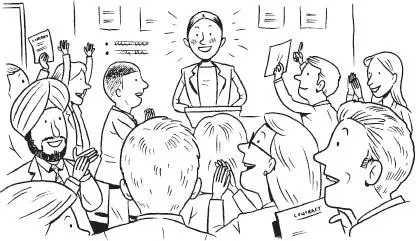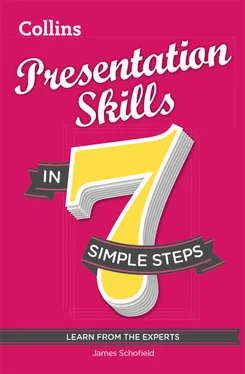Presenting will give you great opportunities to network with a lot of like-minded people at the same time. Who knows, one of them might be the person who gives you your dream job at some time in the future.

Before you start work on your presentation, it’s smart to do some research. The more you find out about what’s required in advance, the better the end result.
The first thing you need to find out is what kind of presentation is required. There are several types, each with its own distinct purpose and challenges.
This is the most frequent type of presentation. It’s used for bringing a group of people up to speed about a topic of mutual relevance, for example sharing information about the status of a project or changes in the organisation. Sometimes you might be asked to present regularly at a monthly meeting. It’s important for information-sharing presentations to sound neutral because people need to be allowed to draw their own conclusions about what you tell them. If you don’t sound neutral, then you run the risk that your audience will reject what you say because they believe you to be biased. So the challenge lies in sounding neutral without being dull. You can do this by making clear to people how something affects them directly: As soon as the system is ready , we need to be able to use it efficiently .
Although a lot of companies now use fewer classroom training sessions, there are still many situations where they are the best way to share knowledge quickly. If you are the expert for a particular system, process or tool, you may be asked to train other users even if you don’t have a background in training.
The difficulty is to judge how quickly your audience will get the key points. What might seem dead easy to you could be baffling to them. On the other hand, if you make things too easy, you run the risk of your audience feeling patronised. A good approach is to collect feedback as you go. This could take the form of asking ‘test’ questions after each central point: So, those are the advantages I see with the new software. How do you feel about them ? This helps you to gauge if you’re getting the content level right for your audience.
For some people ‘selling’ is still a dirty word. It smacks of pushy door-to-door sales people or TV shopping channels. But actually, we all need to sell things, even if it’s our own skills, when we go for a job interview.
The key to being good at sales is to think how your product or service will make the life of the listener better: Using this database is going to make your research much more accurate . If you approach sales with this attitude, you can feel comfortable with what you are doing.
It’s a fact that most people don’t like change. We’re all creatures of habit so when we first hear about something new, we tend to reject it as unnecessary. There is often an element of fear in this response. A change can have an impact on people’s own interests, aspects of their jobs and even their personality, and as a result, an audience may have very negative reactions to the presenter. Everyone who tries to introduce change experiences this, from a top CEO trying to restructure her entire company down to a team assistant who wants to convince his office colleagues that a new rota system for making coffee in the morning is mission critical.
What can you do to combat this? The best way is to get the people affected involved in discussion. Simply informing them of a change is likely to lead to resistance, either active ( Who do you think you are? I’m not doing that! ) or passive ( I’ll get round to doing that – sometime ). So outline to the audience what the current situation is, give clear reasons why change is necessary, outline possible solutions, and then engage the audience in discussion about the merits or demerits of these solutions. Let the audience see that you are interested in their opinions and want to involve them in finding the best solution. That way you’ll get them on board and willing to cooperate.
Once you’ve worked out what kind of presentation is needed, you can move on to thinking about what you need to achieve. To do this, you need to answer four key questions.
How much time have you got?
What practical details should you check about the audience?
What influence does their part of the company have on them?
What is your goal in the time available?
1 How much time have you got?
This is a question that needs to be clarified with the presentation organisers before you start detailed preparation. It’s important because if you don’t know how much time you have, it’s easy to produce too much material for the time you have available. There are several possible consequences.
You’re asked to stop before you get to the conclusion.
You rush through your material and lose your audience because they can’t keep up with you.
You don’t have enough time to deal with questions from your audience.
It’s hard to define how much time you should allow for questions and discussions because it depends on how controversial the topic is and the type of presentation you’re giving. But in general, it’s advisable to plan for at least twenty-five per cent of your time slot to be given over to dealing with questions.
2 What practical details should you check about the audience?
Your audience should always be in the foreground of your preparation. Ask yourself these questions.
How many people will be there? The number will have an impact on what technology you use and how you talk to them. If it’s only a small number, you can ask them direct questions or get them to discuss something. With a larger audience, you might need a microphone and speakers.
What do they know about my topic already? Don’t overestimate their knowledge or underestimate their intelligence. If it’s a complex topic, use a simple analogy that they can relate to. For example, you could compare an electrical circuit with traffic flow controlled by traffic lights. If you’re giving an internal presentation, think about what your colleagues already know and what will be new to them.
How do they feel about my topic? The reaction of your audience can normally be predicted. Be ready for this by preparing concrete evidence to confirm what you’re saying.
What can they do with the information they get from me? Ideally, you should give your audience something they can take away and use themselves. On the other hand, in a regular internal meeting you may need to get information from some of your colleagues. Make sure you get it.
Take this pro-active approach to your presentation and it will come through in the way that you talk about your subject. If you treat an audience as you would a friend, they’ll return the favour.
3 What influence does their part of the company have on them?
Читать дальше














